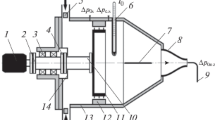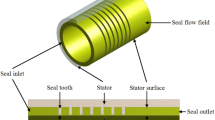Abstract
A comparative analysis of the influence of steam leakage through vane, gland, and shaft seals on the rotordynamics of the high-pressure rotor of a 1,000 MW ultra-supercritical steam turbine was performed using numerical calculations. The rotordynamic coefficients associated with steam leakage through the three labyrinth seals were calculated using the control-volume method and perturbation analysis. A stability analysis of the rotor system subject to the steam forcing induced by the leakage flow was performed using the finite element method. An analysis of the influence of the labyrinth seal forcing on the rotordynamics was carried out by varying the geometrical parameters pertaining to the tooth number, seal clearance, and inner diameter of the labyrinth seals, along with the thermal parameters with respect to pressures and temperatures. The results demonstrated that the steam forcing with an increase in the length of the blade for the vane seal significantly influences the rotordynamic coefficients. Furthermore, the contribution of steam forcing to the instability of the rotor is decreased and increased with increases in the seal clearance and tooth number, respectively. The comparison of the rotordynamic coefficients associated with steam leakage through the vane seal, gland seal, and shaft seal convincingly disclosed that, although the steam forcing attenuates the stability of the rotor system, the steam turbine is still operating under safe conditions.
Similar content being viewed by others
Abbreviations
- A :
-
unsteady cross-sectional area of the cavity (m2)
- A 0 :
-
steady annular flow area (m2)
- C 0 :
-
orifice contraction coefficient
- C 1 :
-
kinetic energy carry-over coefficient
- C r :
-
steady radial clearance (m)
- [C]:
-
matrix of damping coefficients for the rotor system with seals
- h 0 :
-
stagnant enthalpy (J/kg)
- h 0iseal :
-
enthalpy at the ith orifice (J/kg)
- H :
-
unsteady labyrinth seal radial clearance (m)
- \({H_1 \left({\theta, t}\right)}\) :
-
perturbation clearance (m)
- [K]:
-
matrix of stiffness coefficients for the rotor system with seals
- L :
-
cavity length (m)
- m i :
-
steady-state leakage flow rate at the ith orifice (kg/s)
- [M]:
-
matrix of mass for the rotor system with seals
- N :
-
tooth number
- P 0i , P i :
-
steady and unsteady pressure at the ith cavity (Pa)
- P 1i (θ, t):
-
perturbation pressure in the ith cavity (Pa)
- \({\dot{q}_{0i},\dot {q}_i}\) :
-
steady and unsteady leakage flow rate per unit length (kg/s-m)
- \({\dot {q}_{1i}\left({\theta, t}\right)}\) :
-
perturbation leakage flow rate per unit length (kg/s-m)
- R s :
-
rotor radius (m)
- U 0iseal :
-
velocity at the ith orifice (m/s)
- V 0i , V i :
-
steady and unsteady circumferential velocities in the ith cavity (m/s)
- \({V_{1i}\left({\theta,t}\right)}\) :
-
perturbation circumferential velocities in the ith cavity (m/s)
- {Z}:
-
displacement tensor
- \({\{{\dot{Z}}\}}\) :
-
velocity tensor
- \({\{{\ddot{Z}}\}}\) :
-
acceleration tensor
- δ i :
-
the ith order logarithmic decrement
- ρ 0i , ρ i :
-
steady and unsteady gas density in the ith cavity (kg/m3)
- ρ 1i (θ, t):
-
perturbation gas density in the ith cavity (kg/m3)
- ρ 0iseal :
-
steady gas density at the ith clearance (kg/m3)
- τ r0i , τ ri :
-
steady and unsteady shear stresses at the rotor wall (N/m2)
- τ r1i (θ, t):
-
perturbation shear stress at the rotor wall (N/m2)
- τ s0i , τ si :
-
steady and unsteady shear stresses at the stator wall (N/m2)
- τ s1i (θ, t):
-
perturbation shear stress at the stator wall (N/m2)
- θ :
-
azimuthal position
- α r :
-
dimensionless shear stress length at the rotor wall
- α s :
-
dimensionless shear stress length at the stator wall
- ω ci :
-
the ith order critical rotating speed (rpm)
References
Thomas, J.P.: Investigation into the flow-induced instability of high-pressure rotors of large steam turbines, University of Pennsylvania, Dissertation of Ph.D. (1988)
Kim H.S., Cho M., Song S.J.: Stability analysis of a turbine rotor system with Alford forces. J. Sound Vib. 260, 167–182 (2003)
Chupp R.E., Hendricks R.C., Lattime S.B.: Sealing in turbomachinery. J. Propulsion Power 2, 313–349 (2006)
Bashschmid N., Pennacchi P., Vania A.: Steam-whirl analysis in a high-pressure cylinder of a turbo generator. Mech. Syst. Signal Process. 22, 121–132 (2008)
Hirano, T., Sasaki, T., Sakakida, H., et al.: Evaluation of rotordynamic stability of a steam turbine due to labyrinth seal force. In: International Conference on Power Engineering, October 23–27, Hangzhou, China (2007)
Wang W.Z., Liu Y.Z., Chen H.P. et al.: Computation of rotordynamic coefficients associated with leakage steam flow through labyrinth seal. Arch. Appl. Mech. 77, 589–595 (2007)
The International Association for the Properties of Water and Steam, Release on the IAPWS industrial formulation 1997 for the thermodynamic properties of water and steam, Erlangen, Germany, September (1997)
Wang W.Z., Liu Y.Z., Meng G. et al.: A nonlinear model of flow-structure interaction between steam leakage through labyrinth seal and the whirling rotor. J. Mech. Sci. Technol. 23, 3302–3315 (2009)
Cofer J.I.: Advanced in steam path technology. ASME J. Eng. Gas Turbines Power 118, 337–352 (1996)
Childs D.W., Scharrer J.K.: Theory versus experiment for the rotordynamic coefficients of labyrinth gas seals: Part II—a comparison to experiment. J. Vib. Acoust. Stress Reliabil. Des. 110, 281–287 (1988)
Liu Y.Z., Wang W.Z., Chen H.P., Ge Q., Yuan Y.: Influence of leakage flow through labyrinth seals on rotordynamics: numerical calculations and experimental measurements. Arch. Appl. Mech. 77, 599–612 (2007)
Thomas H.J.: Unstable oscillations of turbine rotors due to steam leakage in the sealing glands and the buckets. Bull. Sci. A.J.M. 71, 223–236 (1958)
Dursun E., Kazakia J.Y.: Air flow in cavities of labyrinth seal. Int. J. Eng. Sci. 33, 2309–2326 (1995)
Dursun E.: Rotordynamic coefficients in stepped labyrinth seal. Comput. Methods Appl. Mech. Eng. 191, 3127–3135 (2002)
Yucel U.: Calculation of leakage and dynamic coefficients of stepped labyrinth gas seals. Appl. Math. Comput. 152, 521–533 (2004)
Yucel U., Kazakia J.Y.: Analytical prediction techniques for axisymmetric flow in gas labyrinth seals. ASME J. Eng. Gas Turbines Power 123, 255–257 (2001)
Author information
Authors and Affiliations
Corresponding author
Rights and permissions
About this article
Cite this article
Jiang, P.N., Wang, W.Z., Liu, Y.Z. et al. Influence of steam leakage through vane, gland, and shaft seals on rotordynamics of high-pressure rotor of a 1,000 MW ultra-supercritical steam turbine. Arch Appl Mech 82, 177–189 (2012). https://doi.org/10.1007/s00419-011-0547-7
Received:
Accepted:
Published:
Issue Date:
DOI: https://doi.org/10.1007/s00419-011-0547-7




